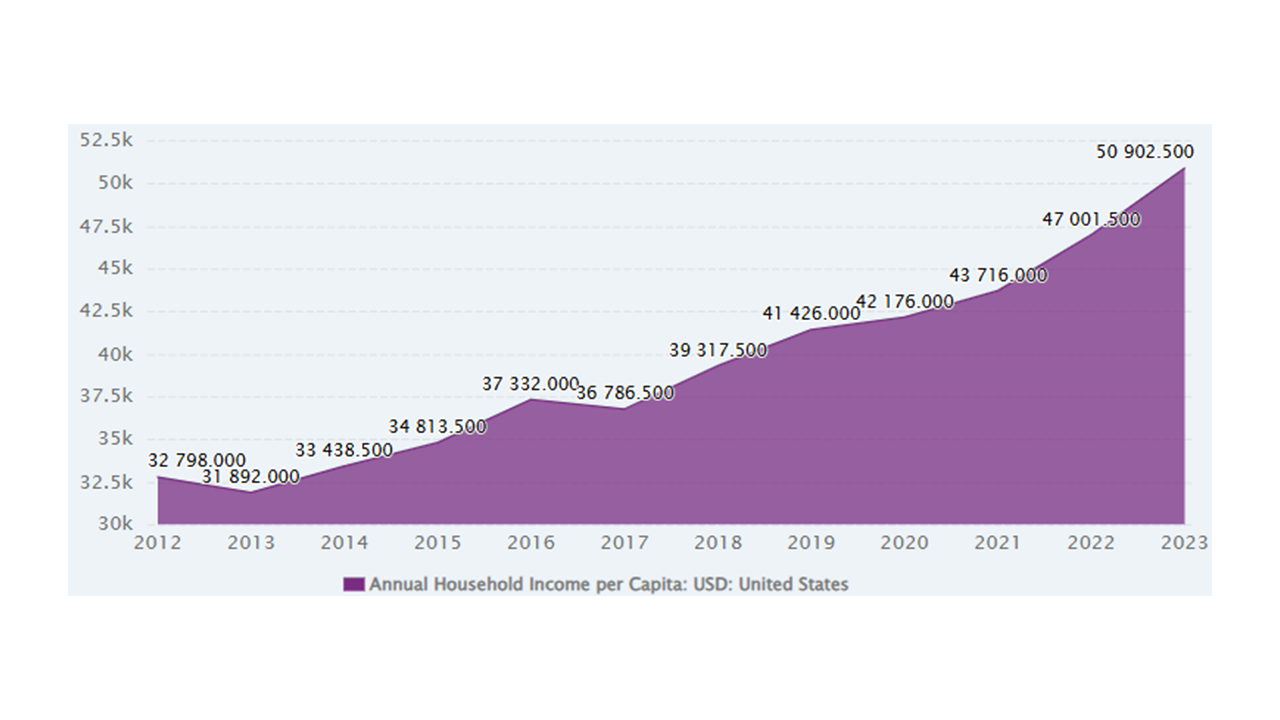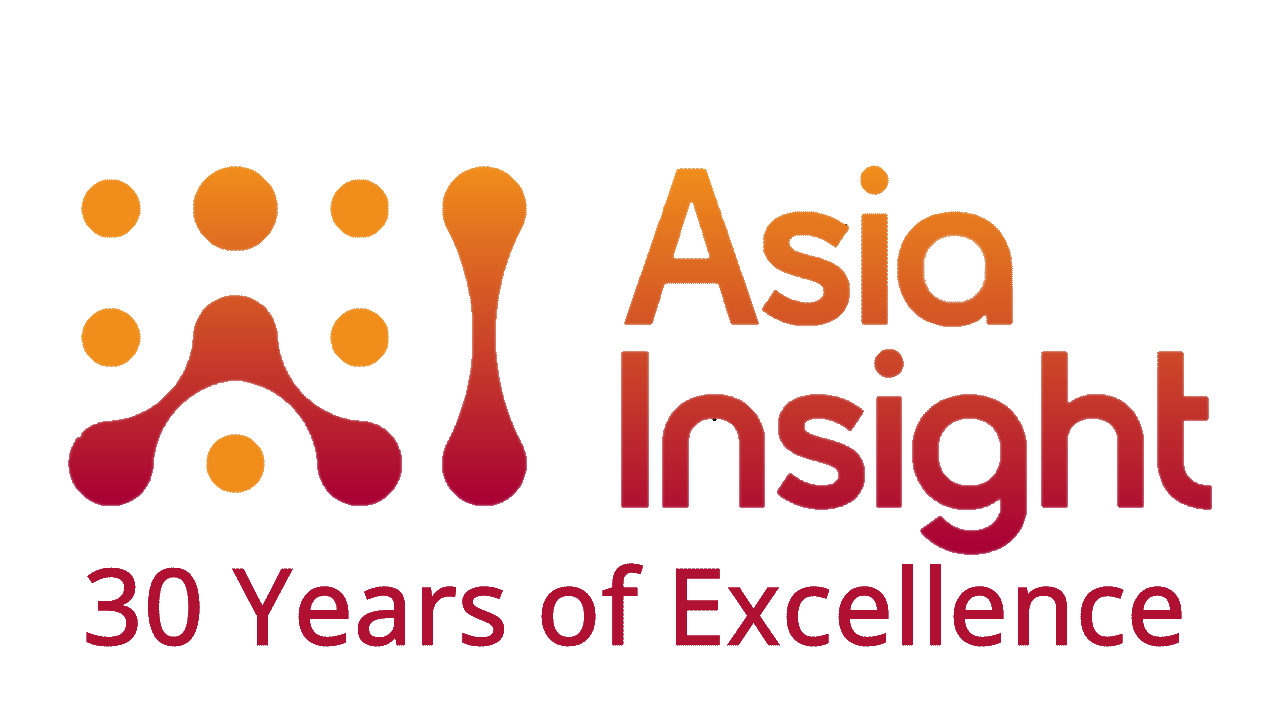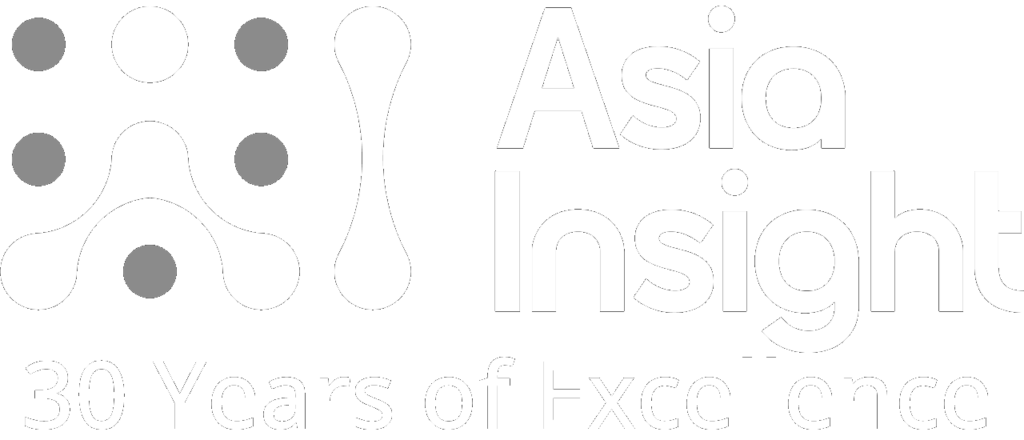Market Insights: United States

Overview of the United States’ Economy
The United States (U.S.) is a global leader in economic influence and innovation. From its origins as a fledgling nation to its current role as the world’s largest economy, the United States has undergone an extraordinary evolution driven by ambition, creativity, and resilience. As a country that spans continents and encompasses a rich variety of cultures, landscapes, and industries, the United States is a dynamic force in shaping global trends and driving change.
Known for its entrepreneurial spirit and strong infrastructure, the U.S. economy is driven by a highly skilled workforce, cutting-edge technology, and robust financial markets. Through periods of both growth and challenge, the nation has shown remarkable adaptability and resilience.
The United States continues to build on its historical foundations while embracing forward-thinking strategies, reinforcing its role as a global economic leader.
GDP Growth
As a global leader in economic power, the United States has experienced notable economic growth over the years, driven by innovation, entrepreneurship, and a highly dynamic workforce.
In 2020, its economy contracted by 2.2%, with GDP falling to $21.35 trillion due to the global pandemic. However, it rebounded strongly in 2021, growing by 6.1% to reach $23.68 trillion, showcasing its economic resilience. Growth continued in subsequent years, with GDP reaching $27.72 trillion in 2023 and per capita income rising to $82,769, reflecting a 2.9% increase. This sustained expansion underscores the nation’s adaptability, driven by a diverse economy, a strong technology sector, and robust consumer spending.
Historically, the United States economy has demonstrated steady expansion. In 2000, GDP was $10.25 trillion, with a per capita income of $36,330. Since then, it has grown consistently, averaging an annual growth rate of 2.5% over the last decade. Key drivers of this sustained growth include technological advancements, a highly skilled workforce, and strong foreign investment.
| Year | GDP | Per Capita | Growth (%) |
| 2023 | $27.72T | $82,769 | 2.9 |
| 2022 | $26.01T | $78,035 | 2.5 |
| 2021 | $23.68T | $71,318 | 6.1 |
| 2020 | $21.35T | $64,411 | -2.2 |
| 2019 | $21.54T | $65,605 | 2.6 |
| 2018 | $20.66T | $63,201 | 3.0 |
| 2017 | $19.61T | $60,322 | 2.5 |
| 2016 | $18.80T | $58,207 | 1.8 |
| 2015 | $18.30T | $57,040 | 2.9 |
| 2014 | $17.61T | $55,304 | 2.5 |
| 2013 | $16.88T | $53,410 | 2.1 |
| 2012 | $16.25T | $51,784 | 2.3 |
| 2011 | $15.60T | $50,066 | 1.6 |
| 2010 | $15.05T | $48,651 | 2.7 |
| 2009 | $14.48T | $47,195 | -2.6 |
| 2008 | $14.77T | $48,570 | 0.1 |
| 2007 | $14.47T | $48,050 | 2.0 |
| 2006 | $13.82T | $46,302 | 2.8 |
| 2005 | $13.04T | $44,123 | 3.5 |
| 2004 | $12.22T | $41,725 | 3.8 |
| 2003 | $11.46T | $39,490 | 2.8 |
| 2002 | $10.93T | $37,998 | 1.7 |
| 2001 | $10.58T | $37,134 | 1.0 |
| 2000 | $10.25T | $36,330 | 4.1 |
The steady increase in GDP over the years showcases the country’s ability to adapt to shifting global dynamics, including the 2008 financial crisis and the more recent pandemic. Its economic resilience is further reflected in its ability to maintain consistent growth despite challenges such as trade tensions, domestic policy shifts, and global market fluctuations.
As the United States advances its economic trajectory, it prioritizes technological innovation, infrastructure development, and strategic investments to drive sustainable growth. While challenges remain, the nation’s resilience and adaptability reinforce its position as a global economic leader, ensuring its continued influence on the world stage.
Foreign Direct Investments
In 2020, the United States experienced a sharp decline in Foreign Direct Investment (FDI), falling 56.6% from 2019 to $137.07 billion due to the pandemic. However, 2021 saw a remarkable rebound, with FDI surging 247.1% to $475.81 billion, reflecting renewed investor confidence. This momentum slowed in 2022, as FDI declined 14.0% to $408.98 billion, followed by another 14.7% drop in 2023 to $348.78 billion. Despite these fluctuations, the United States remains a leading global destination for foreign investment.
FDI flows into the United States encompass equity investments, reinvested earnings, and other capital, allowing foreign investors to directly impact U.S. businesses while leveraging the country’s economic strength and stability.
Its FDI trends demonstrate both resilience and the country’s continued appeal as a leading global investment hub. Despite recent fluctuations, the United States remains a top choice for foreign investors seeking opportunities in a robust and innovative economy.
Growing Markets & Markets with High Growth Potential
The country continues to see immense opportunities for growth in several key sectors as a global economic leader. These industries are poised to play a pivotal role in shaping the U.S. economy in 2023 and beyond.
Renewable Energy Transition: The United States is making significant strides in the renewable energy sector, with a focus on solar, wind, and energy storage technologies. As part of its commitment to combat climate change, the country is increasingly investing in clean energy solutions to transition away from fossil fuels. This growing market offers opportunities for innovation and the development of sustainable energy infrastructure.
Artificial Intelligence (AI) and Automation: With a growing demand for efficiency and productivity, the U.S. is at the forefront of the AI and automation revolution. From autonomous vehicles to AI-powered services, these technologies are transforming industries and creating new business opportunities. As the labor market evolves, AI and automation offer solutions to workforce challenges while fostering economic growth.
Healthcare and Biotechnology Innovation: Its healthcare and biotechnology sectors are experiencing rapid growth, driven by technological advancements, an aging population, and increasing healthcare needs. This includes pharmaceuticals, medical devices, telemedicine, and health tech innovations. Foreign businesses with the right expertise can capitalize on this lucrative market by providing cutting-edge solutions to meet the nation’s healthcare demands.
E-Commerce and Digital Services: The e-commerce sector continues to thrive in the United States, driven by shifting consumer behavior and increasing online shopping. With the rise of digital platforms, e-commerce presents significant growth potential for businesses across various industries, from retail to logistics and digital services. Innovations in online retail, supply chain solutions, and digital marketing will continue to fuel this sector’s expansion.
Sustainability and Green Consumerism: With sustainability becoming a consumer priority, demand for eco-friendly products and services is surging in the U.S. market. From sustainable packaging to green building solutions, brands that embrace environmental responsibility can gain a competitive edge. Consumers increasingly seek products that reflect their values, creating opportunities for businesses that lead in sustainability.
Fintech and Financial Innovation: The fintech sector in the United States is growing rapidly, driven by the rise of digital banking, cryptocurrency, and blockchain technologies. With advancements in financial technology, businesses have the chance to innovate and disrupt traditional financial systems. This evolving market presents opportunities for new solutions in payments, lending, and investment platforms.
The United States offers significant opportunities for growth across multiple high-potential sectors, from renewable energy and AI to healthcare, e-commerce, sustainability, and fintech. Businesses that invest in innovation, stay attuned to market trends, and understand consumer demands will find abundant prospects in the U.S. market as it continues to evolve and expand.
United States’ Demographics
Home to approximately 345 million people, the United States is defined by its rich ethnic diversity and cultural pluralism, shaped by generations of immigration. While English is the dominant language, Spanish is widely spoken in many regions, alongside numerous other languages that reflect the nation’s multicultural heritage.
Christianity is the largest religion in the U.S., with Protestantism and Catholicism being the most prominent denominations. Additionally, other religions, including Judaism, Islam, and Buddhism, have significant communities, contributing to the country’s religious diversity.
The United States is a highly urbanized nation, with approximately 82.4% of its population residing in urban areas. This reflects a strong trend toward modernization and economic growth, with major metropolitan regions like New York City, Los Angeles, and Chicago acting as key cultural and economic centers.
The United States has a median age of 38.3 years, younger than many developed nations due to immigration and higher fertility rates. The fertility rate is 1.6 births per woman, slightly below replacement level. Life expectancy is 79.5 years, reflecting a strong healthcare system, though disparities in access contribute to a lower rate compared to other developed countries.
In December 2023, U.S. annual household income per capita rose to $40,722, up from $39,167 the previous year. This marks significant growth from the average of $21,116 between 1984 and 2023. Retail sales also showed positive momentum, with a 1% year-over-year increase in May 2023, reflecting a strong consumer-driven economy.

The United States features a diverse demographic landscape, marked by urbanization and economic growth. Despite challenges like a declining fertility rate and healthcare disparities, rising household incomes and retail growth highlight its resilience. With a young median age and consumer-driven economy, the U.S. remains a global leader poised for continued innovation.
United States Consumers and Consumer Trends
In the fast-paced and diverse landscape of the U.S. consumer market, understanding evolving trends and shifting preferences is essential for businesses seeking to maintain a competitive edge. This report highlights key insights into the American consumer’s behaviors and preferences, offering valuable guidance for companies looking to tailor their strategies to the U.S. market.
Consumer Characteristics
U.S. consumers value convenience, innovation, and personalization. They tend to gravitate toward brands that offer convenience in purchasing, customer service, and delivery options. Additionally, they appreciate companies that offer customizable or personalized experiences in both product offerings and marketing strategies. Consumers are also increasingly driven by values, seeking brands that align with their personal beliefs, especially regarding sustainability, diversity, and social responsibility.
Shift Toward Experiential Spending
U.S. consumer spending is shifting toward experiences over material goods, driven by Millennials and Gen Z seeking meaningful, shareable moments. Despite pandemic setbacks, industries like travel and leisure have rebounded. Digital platforms are crucial, with more consumers booking experiences online, highlighting the need for businesses to maintain a strong digital presence.
Shift to Online Shopping
E-commerce continues to rise as consumers prefer the convenience of online shopping. Many have adjusted their habits due to higher prices, with clothing being a top online category. Generation Z is leading the trend, shopping more on social media and marketplaces. Payment options like Buy Now Pay Later and digital wallets are further boosting online shopping, a shift that began during the pandemic and continues to grow.
Sustainability Focus
Consumers are increasingly prioritizing sustainability, with many willing to pay more for eco-friendly products. However, consumer packaged goods (CPG) companies face challenges in converting this interest into sales, as products with environmental or social claims often underperform. Understanding how these claims influence purchasing decisions is crucial for businesses investing in environmental, social, and governance (ESG) initiatives.
Health and Wellness Focus
The U.S. health and wellness industry is shifting towards technology, sustainability, and personalized care. Consumers are prioritizing experiences that promote well-being, such as wellness-focused travel and home amenities. Digital health solutions, including connected technologies, are gaining traction, enabling remote care and personalized health management, fostering proactive health measures and greater patient engagement.
Personalization
Personalized shopping is growing in the United States, with retailers using data, AI, and machine learning for tailored recommendations and promotions, boosting satisfaction and sales. This trend spans sectors like fashion, beauty, and technology. Personalized tactics, such as custom landing pages and email campaigns, enhance engagement, loyalty, and revenue by making shopping more relevant to consumers.
The U.S. consumers are shifting toward online shopping, experiential spending, and sustainability, with a strong focus on convenience, personalization, and values like health and wellness. Businesses that embrace these trends—offering tailored experiences, eco-friendly products, and a strong digital presence—will be better positioned to succeed in the evolving market.
Key Takeaways
1.Economic Growth: The U.S. economy remains a global leader, with a steady GDP growth rate of 2.9% in 2023, driven by technological innovation, strong consumer spending, and resilience through challenges like the pandemic and financial crises.
2.Foreign Investment Resilience: Despite fluctuations, the U.S. continues to attract significant foreign direct investment, with $348.78 billion in 2023, reflecting confidence in its economic stability and growth potential.
3.Growth Sectors: Key industries with high growth potential in the U.S. include renewable energy, artificial intelligence, healthcare, e-commerce, and fintech, offering opportunities for innovation and business development.
4.Diverse Demographics: The U.S. has a young, multicultural population with a high degree of urbanization. This diversity shapes the economy, making it adaptable and dynamic, with varying consumer preferences and market demands.
5.Consumer Trends: U.S. consumers are shifting toward online shopping, experiential spending, and sustainability. Personalization, convenience, and alignment with values such as health and eco-friendliness are becoming crucial for businesses to succeed.
6.Technological Adaptation: The U.S. is embracing digital transformation, with e-commerce, online payment systems, and AI-driven solutions reshaping consumer habits and business models. Companies that leverage these trends are better positioned for future success.
Sources
- https://data.worldbank.org/indicator/NY.GDP.MKTP.CD?end=2023&locations=US&start=2000&view=chart
- https://data.worldbank.org/indicator/NY.GDP.PCAP.CD?end=2023&locations=US&start=2000&view=chart
- https://data.worldbank.org/indicator/NY.GDP.MKTP.KD.ZG?end=2023&locations=US&start=2000&view=chart
- https://www.macrotrends.net/global-metrics/countries/USA/united-states/foreign-direct-investment#:~:text=U.S.%20foreign%20direct%20investment%20for%202022%20was%20%24408.98B%2C%20a,a%2056.62%25%20decline%20from%202019
- https://news.gallup.com/poll/358364/religious-americans.aspx
- https://www.worldometers.info/demographics/us-demographics/
- https://www.ceicdata.com/en/indicator/united-states/annual-household-income-per-capita#:~:text=United%20States%20Annual%20Household%20Income,averaged%20value%20of%2021%2C116.200%20USD
- https://www.theguardian.com/film/2024/dec/19/immersive-experience-movies
- https://www.fibre2fashion.com/news/e-commerce-industry/us-consumers-shift-online-shopping-habits-due-to-rising-prices-study-296219-newsdetails.htm
- https://www.mckinsey.com/industries/consumer-packaged-goods/our-insights/consumers-care-about-sustainability-and-back-it-up-with-their-wallets
- https://nypost.com/2025/03/22/lifestyle/vitamin-t-is-latest-vacation-trend-for-travelers-seeking-longer-healthier-lives/
- https://www.mckinsey.com/capabilities/growth-marketing-and-sales/our-insights/the-value-of-getting-personalization-right-or-wrong-is-multiplying
- https://www.thinkwithgoogle.com/consumer-insights/consumer-trends/personalized-shopping-spending-statistics/


